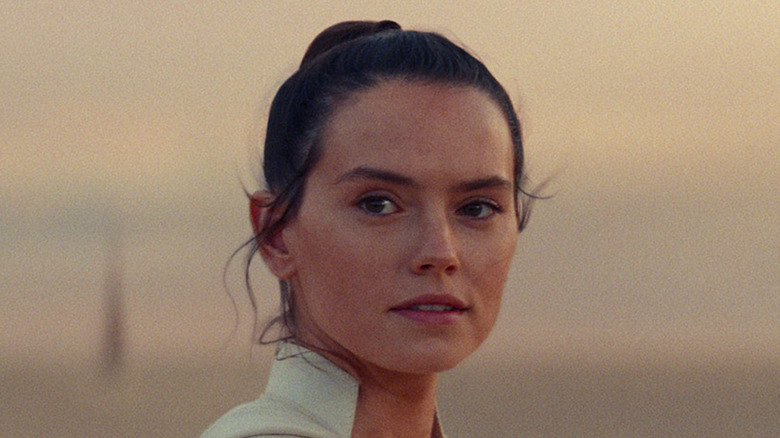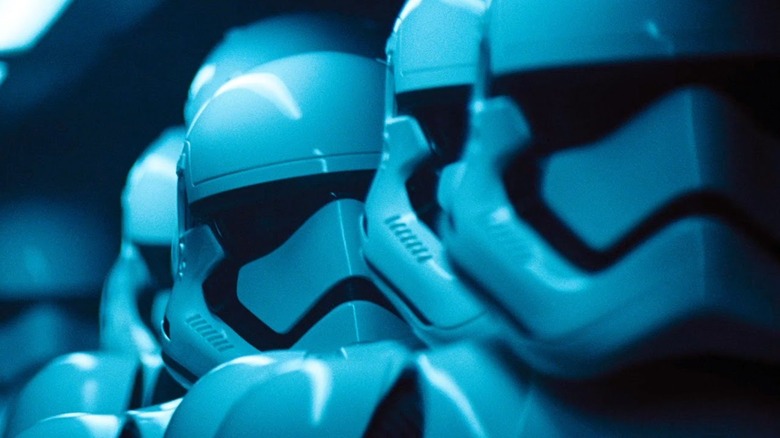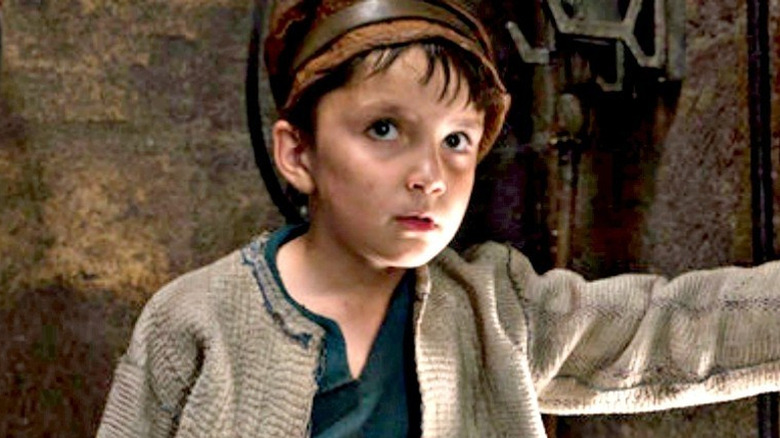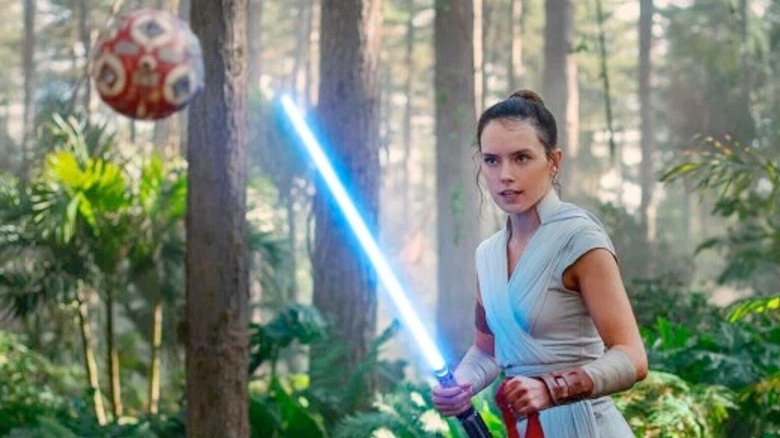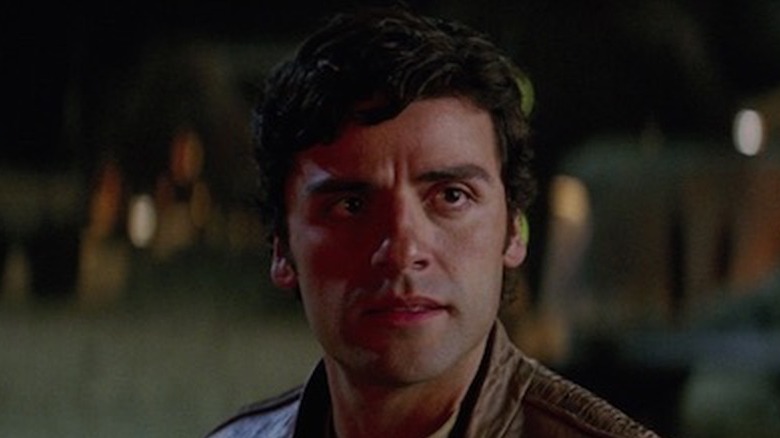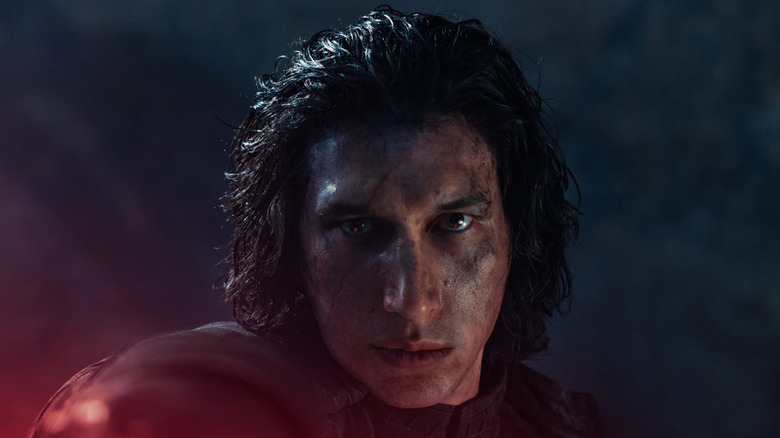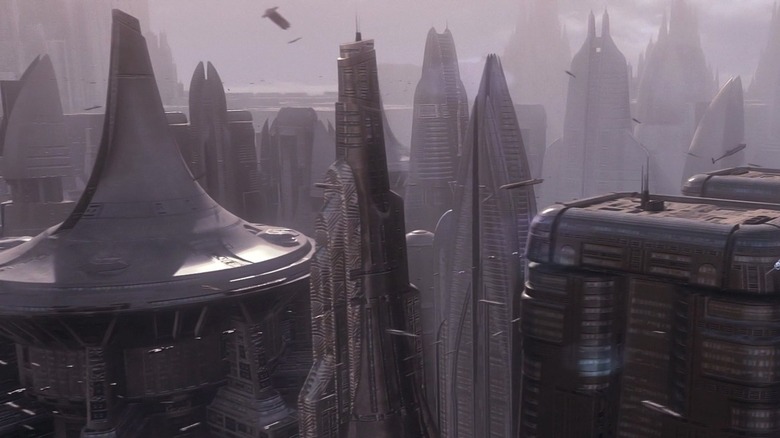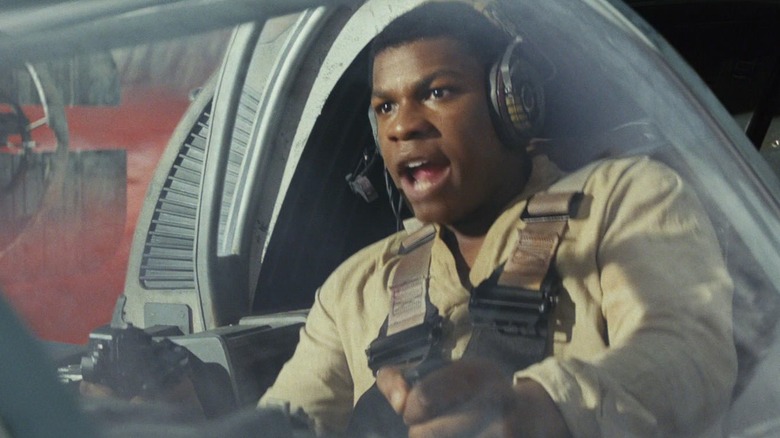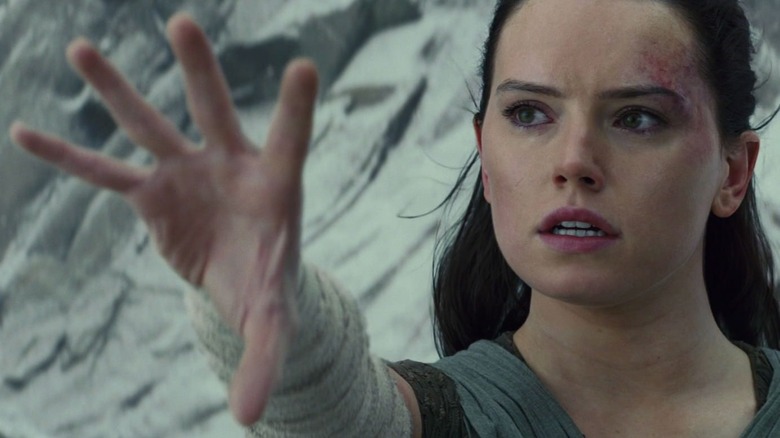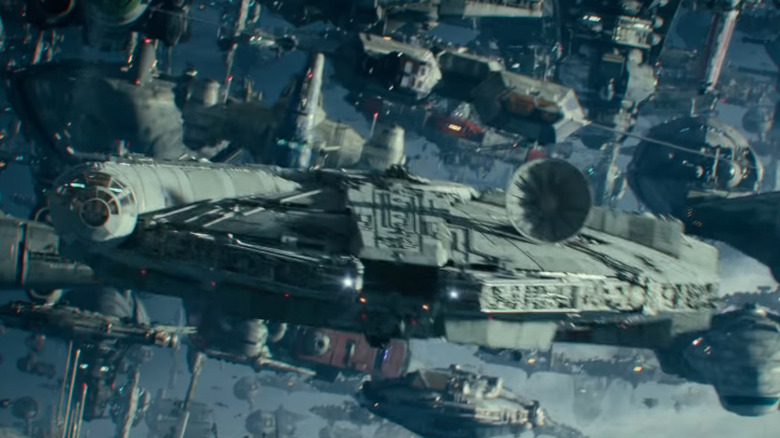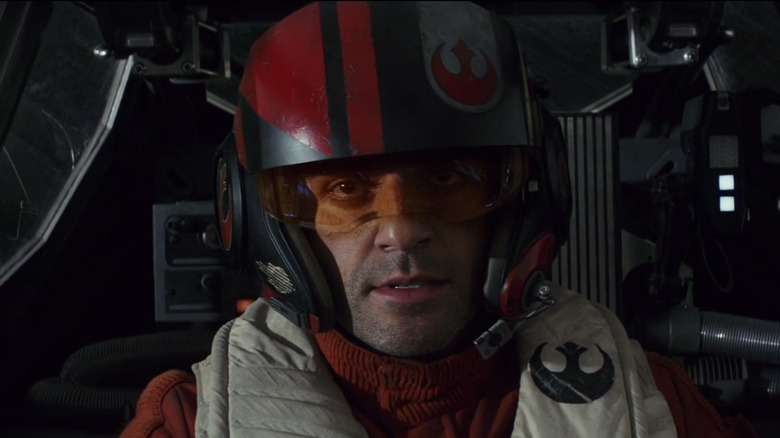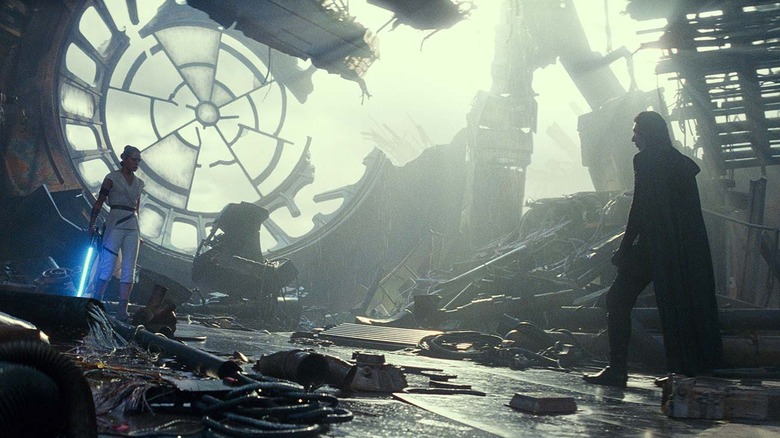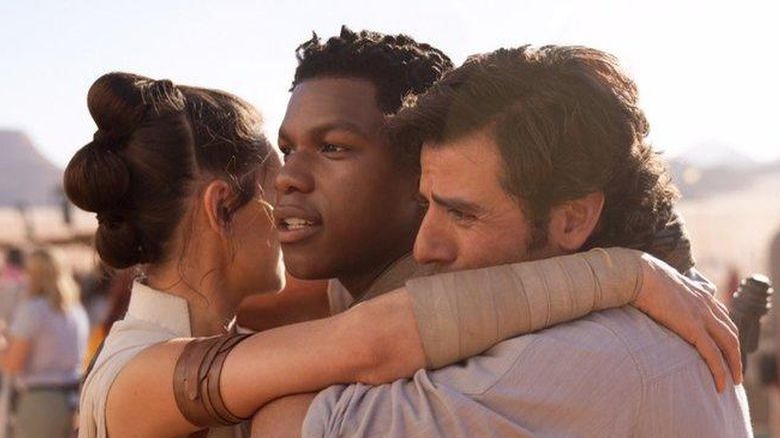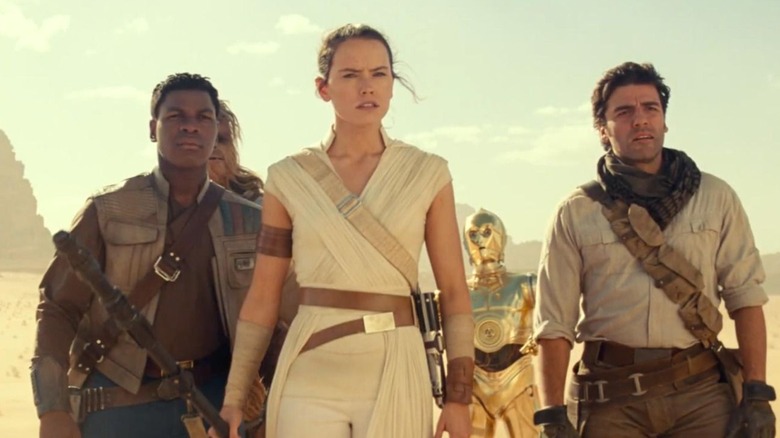The Ending Of Star Wars: The Rise Of Skywalker We Really Wanted
"Star Wars: The Rise of Skywalker" was intended as a finale not just for the Sequel Trilogy that began with "The Force Awakens," but also the nine-chapter "Skywalker Saga" that has served as the core of the franchise's mythology since 1977. This was a daunting task for screenwriters J.J. Abrams and Chris Terrio, who had to cope with an unclear roadmap, a short timetable, and the unexpected passing of one of their lead actors.
We're not here to place blame or claim we could have done it better — we have the benefit of having seen the final film, and having read the unused alternative screenplay "Star Wars: Duel of the Fates" by Derek Connolly & Colin Trevorrow for comparison. It's much easier to look at someone else's work and see what's wrong with it than to come up with fresh ideas. That said, we have our own thoughts as to how "The Rise of Skywalker" should have wrapped up the "Skywalker Saga." We're sure every fan has their own dream version of the "Star Wars" finale (though we've deliberately not consulted any other fan fiction, so any similarities are coincidental), but this is ours, and we hope you'll indulge our hubris in explaining why we think ours might have worked better than the one we got on screen.
A long time ago, in a galaxy far, far away...
The galaxy's status quo must change
The greatest flaw of the "Star Wars" Sequel Trilogy is that the galaxy in which it takes place is not sufficiently different from the Original Trilogy. Say what you will about the prequels, but you'd never mistake a story set during the Clone Wars for one set during the Galactic Civil War of the original films. "The Force Awakens," on the other hand, merely created an extension of the dynamic we enjoyed in the first film. Setting "The Last Jedi" immediately after the end of "The Force Awakens" and "The Rise of Skywalker" only one year later leaves precious little time for any meaningful change and only a narrow window in which to expand this era of "Star Wars" in comics, video games, or television, which is where a lot of the fun of the franchise is had.
Were we to make our own "Episode IX," we'd do things a little differently, beginning with adding a much longer span of time between the end of "The Last Jedi" and the start of the following chapter — let's say about six years. This would allow for the dynamic of the war between the First Order and the Resistance to evolve significantly, and to create some space to tell companion stories set during that change. After all, the Resistance is in tatters at the end of "The Last Jedi" — who's to say it should be rebuilt just as it was?
Introducing a new generation of Jedi
At the very end of "The Last Jedi," we glimpse the cultural impact of Luke Skywalker's last stand against Kylo Ren and the First Order on Crait. The point of Luke's sacrifice isn't merely to buy the Resistance time to escape — it's to reignite the legend of the Jedi so that the next generation can take it in a new, hopefully better direction. In the epilogue, we see a group of enslaved, downtrodden children sharing the story of Luke's final battle, after which one of the children casually calls a broom to his hand with the Force and dreams of freedom. This vignette is not about one individual, but about the countless young people who find hope in Luke's story, and even begin training themselves to use the Force as a result.
By the time of our "Episode IX," an underground movement has been born in which young people are teaching each other how to become Jedi so that they can rise up and defeat the First Order. They're working from incomplete information, passing their training along laterally rather than through a formal hierarchy. The heart of his network is Maz Kanata, who has begun distributing copies of the sacred Jedi text that Rey salvaged from Luke's hut on Ahch-To. Rey herself helps when she can, visiting Resistance cells that have makeshift Jedi study groups, but she can't stay in any one place for too long without attracting the attention of Kylo Ren's Jedi-hunters, the Knights of Ren. For their safety, she must keep her distance.
Rey is making it up as she goes
In "The Last Jedi," we find Luke Skywalker disillusioned with the Jedi ways, planning to let the legacy of the Jedi die with him. Thanks to a wake-up call from Rey and a visit from his late master, Yoda, the story has a different moral — the Jedi don't have to end, they might just need to change.
Rey is now the senior-most Jedi of a new generation, but (much like Luke in "Return of the Jedi") she doesn't have a lot of formal training and has had to develop her own training philosophy. Time to train is also very precious, as she's now one of the Resistance's foremost field commanders (along with Finn) and is always being reassigned to wherever in the galaxy the next and/or most important mission happens to be. While this has contributed to her celebrity among the Resistance and allowed her to share her skills with some young Jedi trainees, it is also profoundly exhausting. Her days as a scavenger on Jakku were hard and lonely, but at least she had a home.
Resistance cells are still small, hit-and-run type operations made up of ordinary people and ex-Republic military, but each cell now has one or two Jedi adepts among their ranks. Lightsabers are a rarity — Rey has been able to cobble one together out of her old staff and a salvaged yellow kyber crystal (as she does at the end of "The Rise of Skywalker"), but most of her students don't have one, which has changed how they train. The Resistance Jedi are teaching themselves different tricks, creating a new Jedi martial art that's more kung fu than kendo.
Poe wrestles with Leia's legacy
"The Rise of Skywalker" was saddled with the unenviable task of bidding goodbye to General Leia Organa without actor Carrie Fisher, who died unexpectedly before filming began. "The Rise of Skywalker" repurposes unused footage from "The Force Awakens" and some digital trickery to incorporate Leia into the story, during which the character also dies from the strain of Force Projection. While Leia's absence from "Episode IX" would have been disappointing, Leia's cobbled-together presence and death in the film are a distraction and it may have been more respectful of Fisher's memory to simply acknowledge her death without incorporating it on screen.
This is another benefit of our six-year time jump — by the time our story opens, General Organa has already passed on, leaving her hand-picked successor Poe Dameron with the burden of command. While Leia isn't around in our version of the story, Poe is still very much in her shadow. Poe has changed since we last saw him, growing into a more responsible leader but perhaps overshooting the mark a bit. He now understands the challenging decisions that Leia and Vice Admiral Holdo had to make in the past and, faced with limited resources and overwhelming odds, his "hot shot" bravado has been all but extinguished. He hasn't flown a mission himself since he took command. Poe's journey in our story is to rediscover his courage and to lead the Resistance into a final, all-or-nothing campaign to dethrone the First Order or die trying.
Victory has defeated Kylo Ren
In "The Last Jedi," Kylo Ren murders his master, Snoke, and supplants him as Supreme Leader of the First Order. His ascent to the throne allows him to stop following in the footsteps of his grandfather, Darth Vader, who was his master's pawn until the day he died. "The Rise of Skywalker" tosses this out and immediately puts him under the thumb of a resurrected Emperor Palpatine, a mistake we won't be repeating.
In our version, Supreme Leader Kylo Ren has successfully maintained the First Order's grip over the galaxy. The Resistance still opposes him, but thanks to his disciples, the Knights of Ren, even the new breed of Jedi hasn't been enough to turn the tide against him. With General Hux serving as his political figurehead on the capital planet of Coruscant, Kylo Ren rarely leaves his throne at the heavily fortified Castle Vader on Mustafar (glimpsed briefly in "Rogue One").
Kylo has one remaining frustration, and that's his failure to tempt Rey over to his side. As in "The Rise of Skywalker," he's learned that prophecy has named them an intrinsically connected dyad in the Force, destined to be together, and yet she's his enemy. This becomes more unacceptable to him as Rey's reputation grows, leading him to arrange for a rare public appearance on Coruscant. This will offer Rey and the Resistance an opportunity he knows they can't resist — Rey will come to fight him, and he'll either turn her or kill her. Either way, he tells himself, he'll be free.
The battle is joined on Coruscant
"The Rise of Skywalker" sets its climax on Exegol, a never-before-seen planet where Palpatine has been secretly amassing an armada of planet-killing weapons. But if we're viewing this as the end of the "Skywalker Saga" as a whole, then there are really only two places where it would feel right to set the finale — Anakin and Luke's home planet of Tatooine, or the city on Coruscant. "The Rise of Skywalker" wisely saves Tatooine for its emotional epilogue, but we think the unused "Duel of the Fates" script had the right idea in setting the saga's final battle at the seat of political power in the "Star Wars" galaxy.
In our version of "Episode IX," Kylo Ren's visit to Coruscant presents an opportunity to take out the First Order's leadership in one fell swoop. The Resistance will never get a better chance to end the war, but General Poe Dameron knows that the effort will probably cost them everything they've got. They'll have to call in every ship, expose every cell, risk the lives of every soldier they have. Poe doesn't know if he can justify sending that many people to die for such a slim chance of victory.
Finn, his closest friend and advisor for these past six years, talks him into it. Finn used to value his life over the cause, but those days are long over. He knows each member of the Resistance would gladly give their lives to free the countless billions living under First Order rule. Poe reluctantly agrees, and the invasion of Coruscant is planned.
Finn leads the ground assault
No character is more failed by "The Rise of Skywalker" than Finn, who doesn't really get an arc of his own. The unused Connolly/Trevorrow script for "Episode IX: Duel of the Fates" gives him a much better ending, one that we don't think we could improve upon. In their draft of the film, Finn, Rose Tico, and Chewbacca are sent on a mission to Coruscant as part of the Resistance's strategy to end the war. While he's there, Finn not only rallies the citizens of the capital planet to organize and rise up, but also makes an appeal to the First Order Stormtroopers who are stationed there. He was once one of them, but he overcame his conditioning and chose to fight not just for his own freedom, but for others'. He'll fight for them, too, if they'll let him. We can't resist folding this development into our "Episode IX."
As in "Duel of the Fates," our version of the insurrection on Coruscant sees Finn and company preparing the citizens of Coruscant for battle before the Resistance invades, taking up arms and repurposing old Imperial and First Order walkers. Finn's uprising is the first step in the larger plan, and when the battle begins on the streets of the capitol, the First Order gives the insurgents their full attention. So far, Finn's gesture to the Stormtroopers has gone unanswered. If the fleet doesn't arrive soon to draw off First Order air support, they'll soon be overwhelmed.
Rey learns from her Padawans
Rey knows that Kylo Ren expects her to come to meet him on Coruscant, but she has other business to attend to on the planet before she confronts him. In advance of the space invasion, Rey, BB-8, and a team of the most skilled Jedi pupils in the Resistance accompany Finn's team to the surface with a mission of their own. While Finn has been sent to Coruscant to make as much noise as possible, Rey's team quietly infiltrates Coruscant's interstellar communications hub to disable their sensors ahead of the fleet's arrival.
Along the journey, Rey has the opportunity to get to know these young learners, who are looking to her as an example. While charmed by their admiration for her, Rey realizes that she is their peer, not their better, that the road to a greater future for the Jedi depends on each adept developing their own relationship with the Force rather than following the examples of those who came before — even her. The Force belongs to no one, and knowledge and wisdom must flow equally between generations.
When Rey's team arrives at the communications hub's control room, they are confronted by the Knights of Ren, who have been waiting for them. A battle ensues in which Rey's Padawans must use their unarmed Force combat skills against the Knights, who each wield a lightsaber-derived weapon. The fight delays them in disabling the sensor net, putting the invasion in jeopardy.
The Resistance fleet assembles
There's one element that exists in both "The Rise of Skywalker" and "Duel of the Fates" that we're quite fond of and would want to retain for our version of the finale, and that's the quest to summon every willing spaceship captain in the galaxy to join in a massive armada for the final battle. The moment when Lando Calrissian leads an absolute wall of ships, some recognizable, some new, to save the Resistance fleet over Exegol is the most gleeful moment in "The Rise of Skywalker." We're happy to more or less copy-paste it into our "Episode IX" — though we do have to recontextualize it a bit.
While Finn and Rey lay the groundwork on Coruscant, Poe and C-3PO work to assemble the Resistance fleet and actually attract a lot more ships than they expect. When early reports from Coruscant are that both Finn and Rey's missions are in jeopardy, Poe begins to wonder if it might be smarter to play it safe, cut their losses, and try to rebuild again with the new fleet they've amassed.
"How can I send all these people into a battle they have almost no chance of winning?" asks Poe.
"You don't send them," a voice responds, "you lead them."
For one, single moment, the Force ghost of General Leia Organa appears to offer Poe an encouraging smile.
The tide turns
Rey and her students' fight against the Knights of Ren is going poorly. The Padawans are artfully applying their fighting style, but are forced to constantly go on the defensive due to their lack of armaments. Rey's attention is split around the room as she intervenes with her blade each time one of the Knights readies a killing blow. The momentum finally shifts when Rey passes her lightsaber to one of the adepts, who then tosses it to another, and to another. Placing their trust in each other and sharing the tools they have, the Jedi triumph over the Knights of Ren. BB-8 deactivates the sensor net and transmits a signal to the fleet that it's safe to launch the invasion, but she fears that if they haven't left the rally point until now, they may arrive too late to make a difference.
Rey's fears are unfounded — the fleet arrives only minutes later, with Poe Dameron at the front of the charge in his X-Wing. Poe, as it happens, gave the order to launch some time ago before he was sure the communications hub was disabled, trusting that his friend would complete her task before they reached sensor range.
News of the fleet's arrival stirs something in the Stormtrooper ranks. Finn's chosen family took this risk for him — they can do it too. Hundreds of Troopers remove their white helmets and switch sides, giving the Resistance the edge in the ground war.
The finale
Knowing that she must confront Kylo Ren alone, Rey encourages her fellow Jedi to join Finn in the battle on the streets. Some of the young Jedi take weapons from the fallen Knights of Ren, some of them do not — each of them will fight on in their own way. With this added edge, Finn's victory is assured. Above, in space, Poe dazzles with his piloting prowess, leading his fighter wing through bold, daring maneuvers. Rediscovering the joy of flying, Poe lets out his first gleeful howl in years.
Meanwhile, Rey and Kylo Ren finally meet in the Imperial Palace throne room before a grand window overlooking the battle. (We had to include some parallelism with "Return of the Jedi" and "Revenge of the Sith.") Kylo admits admiration for the way Rey has reinvented the Jedi. She's taken his advice and "let the past die." Seeing him in Palpatine's old palace, she can't say the same for him. Kylo tells Rey of the prophecy, that they are linked through the Force and belong together. Rey accuses Kylo of becoming a slave to tradition, now that it favors him. Out of words for each other, they fight in silence. They've both grown incredibly powerful, but Rey gains the upper hand by employing the new skills she's learned from the young Jedi. The battle ends with Kylo on his back and Rey's blade stayed at his throat.
Our heroes meet their fates
Through the palace window, Rey can see that the Resistance's victory has been assured. General Hux has been arrested by his own troops, X-Wings pick off the remaining TIE Fighters from the skies, the capitol is theirs. With a sigh, Rey extinguishes her lightsaber and walks away from Kylo Ren. Stunned, indignant, Kylo demands that she return and finish the fight. She says that she has. Kylo again insists that their destinies are intertwined. "Maybe," she replies. "When you're ready to find out, come find me."
As in "The Rise of Skywalker," Rey, Finn, and Poe find each other in the aftermath of the battle and share a warm hug, celebrating their survival and the end of the war. Finn resolves to dedicate himself to rehabilitating his former brethren, both those who have defected and those who have surrendered. Poe imagines there will be a place for him in the government when the Republic is reformed, and he'll take it — eventually. He's not done flying just yet. As for Rey, she thinks she might like some quiet.
In the saga's final scene, a cloaked figure wanders a desert, looking for someone. He finds her — it's Rey, seated in a circle with a number of people, both young and old, in meditation. The figure removes his hood. It's Kylo Ren — or rather — Ben Solo, a humbly defeated man seeking purpose. She nods at him and he joins the meditation circle as the twin suns set over Tatooine.
Completing the saga
As we've acknowledged, it's far easier to look at some other storyteller's work, see its flaws, and rewrite accordingly than it is to stare at a blank page and write "FADE IN:." Even the story ideas that we didn't lift or adapt from the official scripts are still informed by the hindsight they offer. We also had no boundaries, no studio demands, and no pressure to perform — the fate of a multi-billion-dollar property did not hang on our storytelling decisions. We didn't even write a screenplay, just a broad treatment that still needs a lot of fleshing out. There's plenty missing from what we've given you above — we haven't incorporated any romance, we've neglected a few supporting characters, and we'd certainly want to see some more locations action setpieces earlier in the story.
What we have done is offer an alternate path for the finale of "The Rise of Skywalker," one that allows the themes introduced in "The Last Jedi" to progress, that brings this trilogy's lead characters arcs to a logical conclusion, and brings the "Skywalker Saga's" tale of the fall and rebirth of the Jedi Order full circle.
